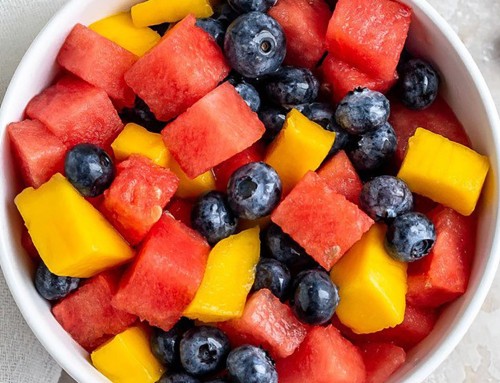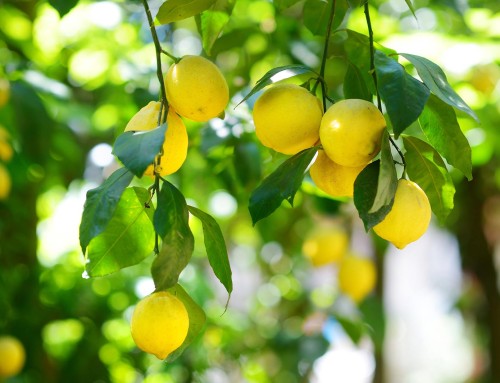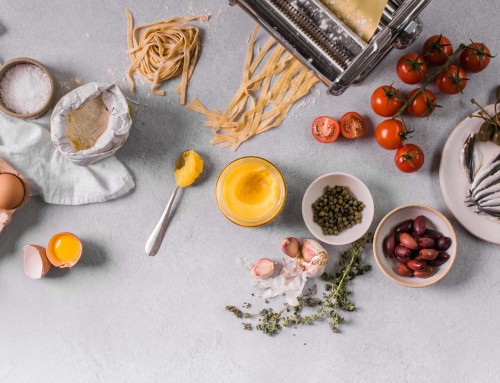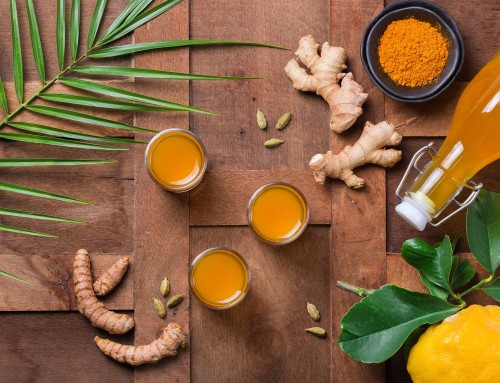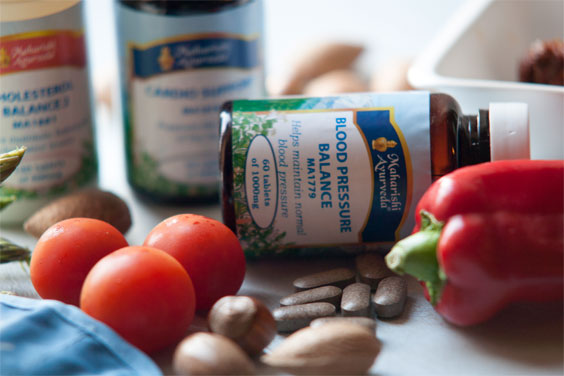
The Ayurvedic Approach to Balancing Blood Cholesterol
In this newsletter we talked to an expert on Ayurveda from The Council of Maharishi Ayurveda Physicians about the Ayurvedic approach to balancing cholesterol.
Read time approximately 35 minutes.
Q: Can you begin by telling us about cholesterol [1] from the perspective of Maharishi Ayurveda?
A: First of all, it is important to understand that cholesterol is not mentioned in the Ayurvedic tradition. Rather, the Ayurvedic texts discuss meda dhatu (lipid tissue) and explain how to maintain a healthy quantity and quality of fat tissue in the body. When meda dhatu is balanced and healthy, that subsequently helps to maintain balanced cholesterol.
Meda dhatu, fat tissue, is one of the seven dhatus, or body tissues. According to Maharishi AyurVeda, the body is a combination of the following:
- Doshas — fundamental physiological governing principles (Vata, Pitta, and Kapha).
- Dhatus — 7 tissue elements that support and sustain the body, including rasa dhatu (nutritive fluid), rakta dhatu (blood plasma), mamsa dhatu (muscle), meda dhatu (fat), asthi dhatu (bone), majja dhatu (bone marrow), and shukra dhatu (sperm and ovum).
- Malas — metabolic impurities (urine, bowels, and sweat).
To understand how to maintain healthy meda dhatu, you first need to understand that balance is the main means and end of Maharishi AyurVeda. A moderate lifestyle, diet and daily routine upholds balanced functioning of every aspect of life: body, mind and senses. Peacefulness in mind, a blissful consciousness, and control over the senses are equally important.
The principle factor behind balance in the body is balanced agni (digestive fire). Digestion is quite literally the basis for good health in every part of the body.
For instance, the creation of healthy body tissue (dhatu) requires a brightly-burning digestive fire, or metabolic process. A strong agni is equally important in maintaining balance in the doshas and malas.
Therefore, when digestion, assimilation and elimination are balanced, fat tissue and cholesterol will also be balanced.
It’s important to understand that cholesterol in itself is not bad and is actually essential for the body to function properly. So, in the Ayurvedic perspective, the production of cholesterol does not necessarily need to be lessened, but it needs to be balanced. When the digestion is balanced and healthy, then the body produces the right amount of cholesterol, in the right proportion to nourish the body.

Q: What causes cholesterol function to become imbalanced?
A: Digestion depends on the strength of the digestive fire (agni). Digestive fire is sustained with the fuel of wholesome foods and drinks. If we eat too little, or if we eat unwholesome foods and drinks, the digestive fire dwindles.
There are 13 agnis that work together in the digestive process. First, the food is metabolized by the main digestive fire (jathar-agni), located in the stomach and duodenum. Next it is metabolized by the five elemental fires located in the liver (bhut-agnis), and finally by seven dhatu-agnis, located in the seven tissues. These 13 types of agnis form the metabolism and digestive system in the body.
When we eat fatty or oily food, it is metabolized by these 13 agnis in a sequential process. Jathar-agni helps to break down the food. The bhut-agnis help to screen toxins and ensure that the food is transformed into healthy, good-quality body tissue. The dhatu-agnis help transform the food into their respective tissues.
So the strength of the various digestive fires is needed for the tissues to be formed properly, including the fat tissue. When the production of meda dhatu is disturbed, the quantity (amount and proportion) and quality (contents) of meda dhatu are also disturbed. In other words, because cholesterol is one of the contents of lipid tissue, the production of cholesterol becomes imbalanced when meda dhatu is imbalanced.

Q: What is the role of the liver in producing healthy fat tissue and balanced cholesterol?
A: It’s important to understand that the liver not only produces cholesterol, but it’s also part of the digestive system. It’s the place where toxins are screened before they enter the bloodstream. If the liver becomes overloaded with toxins, due to certain mental, physical and environmental factors, its functioning can become impaired. When this happens, it disturbs the 13 digestive fires.
This results in one of three types of imbalances: 1) an increase in meda dhatu, 2) a decrease of meda dhatu, or 3) meda dhatu mixed with ama.
When meda dhatu mixes with ama, it changes the quality of fat tissue and the quality of cholesterol, making it unhealthy rather than healthy. This mixing of ama with fat tissue is the main cause of imbalanced cholesterol. And it is the liver (yakrit) that is responsible for qualitative digestion, i.e. the quality, or purity, of the fat tissue and hence the quality of the cholesterol that is being produced.

Q: What are the main causes of imbalanced digestion?
A: These fall into three categories: mental, physical and environmental. Mental causes include too much mental activity or pressures at work as well as emotional factors such as anger, worries, sorrow, and greed.
Physical causes include eating too much (above digestive capacity), eating too little (below the digestive capacity), and eating faulty food (against the digestive capacity). Other physical causes include eating before the previous meal is digested, eating irregular amounts at irregular times of day, eating while suffering from indigestion, suppressing natural urges, constipation, and emaciation.
Environmental causes include eating the wrong foods for the climate or season, as well as eating foods polluted with toxins.

Q: Can you tell us more about these toxins and how they affect us?
A: There are three types of toxins. One, called ama in Ayurveda, is the sticky, foul-smelling waste product of improper digestion. Ama settles first in the digestive tract and, if it continues to accumulate, mixes with the rasa (nutritive fluid) and travels throughout the body, settling in weak areas. Ama is caused by a dull, slow digestion or by eating foods that are too heavy and difficult to digest, such as packaged, frozen, canned, fried, fatty, or leftover foods.
The second type of toxin is called amavisha, and it is a more reactive, dangerous type of ama. Amavisha is created when ama is present for a very long time and is not flushed from the system. When amavisha starts to spread throughout the body, it can mix with the dhatus (body tissues) and the malas (waste products).
If amavisha mixes with the fat tissue, and at the same time one continues to engage in an unhealthy lifestyle or diet, it can cause imbalance and disease in the lipid tissues. These lifestyle errors include: 1) lack of exercise, 2) sleeping during the day, 3) eating excessive amounts of fatty foods, and 4) indulging in alcoholic drinks.
For instance, imbalanced meda dhatu can distort the cardiovascular veins, called the raktavahi srotas in Ayurveda. When they become stiff and clogged, this causes high blood pressure. If amavisha has mixed with the blood and fat tissue, it can distort and damage the srotas (channels that carry fluids of various sorts throughout the body), narrowing the veins as in atherosclerosis.
So ama can cause all of the problems that are associated with impure lipid tissue which in turn are associated with high cholesterol, even though it’s not the cholesterol itself that causes these problems.
Toxins also enter the body from the environment, with exposure to lead and other heavy metals, or water or air pollution. These environmental toxins are called garavisha in Ayurveda, and they are the third type of toxin. Eating food that is grown using chemical fertilizers and pesticides, and food that is prepared with chemicals, additives, and preservatives, can also add to the toxic overload of the liver and result in disturbance of lipid metabolism.

Q: What causes these three types of ama to accumulate in the liver and in the fat tissue?
A: To understand this, we need to look at how the seven tissues (dhatus) in the body are formed. As mentioned earlier, one of the seven dhatus is meda dhatu, fat tissue. All of the tissues are formed in a sequence of metabolic transformations, and the health and strength of each type of tissue is based on the previous one. When you eat food, it is converted into the rasa (nutritive fluid) and from there is transformed into rakta (blood plasma), and in a sequence converts to the mamsa (muscle), meda (fat), asthi (bone), majja (bone marrow), and finally, shukra (reproductive fluid).
If ama has accumulated in the nutritive fluid, blood plasma or the muscle tissue, which are all raw material for forming fat tissue, then that ama will also be present in the fat tissue. So that is one reason for ama in the fat tissue: ama accumulating in the rasa, rakta or mamsa tissues.
A second reason is eating too much of the less healthy types of fat. These are the trans fats produced in hydrogenating vegetable oils found in packaged, processed and fast foods and oxidised fats such as rancid and overheated fats. In the past all saturated fats were considered bad for you by conventional medicine but there is no much less certainty.
I think it’s obvious why you shouldn’t eat fats that are rancid. But overheating fats is just as bad. Margarines used to contain a lot of trans fats but in UK they now do not. Most vegetable oils (corn, sunflower, safflower, sesame) are produced using heat, solvents and other chemicals which results in the creation of free radicals, contributing to the oxidation of fats and cholesterol in the body. Oxidation can happen even if you use cold-pressed oils for frying or cooking foods. (Fats resistant to oxidation in cooking are coconut, butter, palm and olive).
A third reason is just eating too much fat overall. While all of these factors can cause imbalance in meda dhatu the most dangerous combination is eating large quantities of unhealthy fat, which can happen easily if you eat fast foods or processed, packaged foods on a daily basis.

Q: Can you explain how the liver processes fats?
A: Certainly. There are two subdoshas of Pitta, Pachaka Pitta and Ranjaka Pitta, that govern the digestion. Pachaka Pitta governs the breakdown of the food in the stomach and small intestine. Ranjaka Pitta governs the five bhut-agnis, and also bile production, which is important in the digestion of fat.
There are many bitter Ayurvedic herbs that help increase bile production to facilitate proper fat metabolism. Ranjaka Pitta supports the five bhut-agnis that reside in the liver to effectively process fat and prevent imbalanced qualities in the body’s lipids (meda dhatu).
These five bhut-agnis are called the elemental agnis, because each one corresponds to one the five elements: earth (prithvi), water (apu), fire (tejas), air (vayu) and space (akasha).
For example, the food that you eat contains all five elements, and each element in the food is processed by the corresponding agni in your body. So, the tejas agni would process the fire element in food, and the apu agni would process the water element.

Q: And what happens if the liver has to process unhealthy fat or if the fat contains ama, amavisha or garavisha?
A: The bhut-agnis also scan and identify toxins. Fat is processed by all the five bhut-agnis, because even though it is primarily composed of the earth element, it contains a small amount of all five elements. If the fat is unhealthy, then each of these bhut-agnis must scan for toxins and take care of the toxins.
If it is simple ama, the bhut-agnis burn it, because heat purifies ama. If it is amavisha, the bhut-agni first must neutralize it, and then eliminate it from the rasa (nutritive fluid) so it doesn’t get passed on to the body tissues. For the third type of toxin, garavisha, which includes toxins from chemicals, pesticides, or some other environmental causes, the bhut-agnis identify it and store it in the liver.
If the liver is functioning in a healthy way, the bhut-agnis do not let these toxins pass into the body. If the liver is overloaded with too many toxins over a period of time, then it loses its ability to screen and eliminate toxins. If the garavisha crosses the scanning barrier, they often collect in the fat tissue, leading to diseases such as breast cancer.
You can see that the liver acts in a very intelligent way. So that’s why just increasing the bile (or fuel for the agni) is not enough to lower the cholesterol, as is often thought in Western medicine. Yes, it is important to increase bile production, but it’s also important to strengthen the other functions of the liver so it can detect and deal with all the toxins.
Let’s suppose that everything has gone fine, and ama, amavisha and garavisha are scanned and eliminated by the five bhut-agnis. Then the next step is the domain of the dhatu agnis, which, as I explained before, convert the food into body tissue in a sequence.
It’s possible that the rasa, rakta, and mamsa dhatu agnis will do their job, and then the meda dhatu agni, which converts muscle tissue into fat tissue, must perform its function next. If the meda dhatu agni is low or out of balance, or is overloaded, then too much fat or too little fat can be created.
This is why it is so important to eat only the good kind of fat, and to eat only the proper quantity, so that the five bhut-agnis and the meda agni are not overloaded.
It’s also why we have created Ayurvedic food supplements to strengthen the five bhut-agnis and the meda agni so the meda dhatu remains balanced.

Q: What foods contain trans fats and why are they bad for us?
A: Trans fats are harmful in disturbing the ratio of HDL to LDL cholesterol. Consuming a diet high in trans-fat not only raises cholesterol levels but increases risk of heart disease, stroke and type II diabetes.
While governments are encouraging food manufacturers to reduce the levels of trans fats in their products they are still present in many packaged foods such as cakes, biscuits, doughnuts, fried foods and even bread.

Q: What fats are recommended by Maharishi AyurVeda?
A: The two fats recommended by Maharishi AyurVeda are ghee and olive oil. Ghee, or clarified butter, is made by warming butter and separating out the milk solids. What is left is a clear, pure fat that can be heated to high temperatures without destroying its natural qualities.
Ghee provides essential fatty acids (fats that cannot be produced by the body and must be obtained from food). Ghee is the most easily digestible fat, and it contains Vitamins A and E and acts as an antioxidant. It is also a highly-intelligent type of fat, because it is a food that converts quickly into ojas, the master coordinator that integrates consciousness, mind and body. Ojas is another word for nature’s intelligence in the body.
The other oil that is recommended is olive oil. Olive oil is a mainly monounsaturated oleic fat, which means that it actually lowers cholesterol and triglycerides. But it is important to choose first cold-pressed, extra-virgin olive oil, which means that the oil is pressed from the olives without heat or unnatural processing. This method of processing has been followed for thousands of years, and it doesn’t destroy the nutritional quality of the oil, unlike modern processing methods, which involve high heat and chemical additives.
It’s also important not to heat olive oil at high temperatures for cooking. Use it for baking, for salad dressings, and for low-heat sautéing of spices and vegetables. If you need to heat the oil at higher temperatures, it’s better to use ghee.
Both ghee and olive oil are recommended, because nature’s intelligence has not been destroyed in their processing. Ghee contains smaller molecules that pass through the lipid barrier and nourish the brain, which needs a higher proportion fat than the rest of the body to function properly. That is why ghee is known as medhya, a substance that nourishes mental functioning and improves learning, retention and recall, in the same way that certain herbs and Rasayanas nourish the mind.

Q: Even though ghee and olive oil are nutritious, you said it’s possible to cause high cholesterol levels by eating too much of them. How much is too much?
A: That is a very good question. To understand how much, you first need to realize that not everyone is made the same. Each person has a different body type, and for some people, even one teaspoon of ghee used in cooking twice a day may be too much. If you have a Kapha imbalance or are predominantly Kapha, you probably require less fat, and too much fat — even the good kind of fat — could lead to imbalances such as obesity and high cholesterol. A person with a Vata imbalance, on the other hand, needs more healthy oils and fats to stay healthy and to maintain a normal body weight.
But to digest fat, even good fats like ghee and olive oil, a person needs to have a strong agni, or digestive fire. Weak fat metabolism is one problem, but another problem is caused when the digestion is too high, or sharp. Called tikshnagni (literally, sharp agni), this is actually one cause of amavisha, the reactive type of ama.

Q: So is a low-fat diet to lower cholesterol a good idea, from the Ayurvedic perspective?
A: From the ayurvedic perspective, the body also needs a proper amount of fat tissue for supporting and lubricating the body’s channels, known as srotas. Millions of microsrotas carry nutrients to the cells and waste away from the cells. Other srotas are larger, such as the arteries and veins that carry blood to and from the heart. All these srotas, whether large or small, are made of the element akasha, or space, because they are basically hollow. Vayu, the element of air, is responsible for moving blood, air, nutritive fluid or waste through these channels.
Because both Vayu and Akasha are dry by nature, the srotas can become dry and brittle over time. This is especially true in the Vata time of life, from age 60 and older, when the dry, quick-moving Vata dosha predominates. To keep the srotas flexible, elastic and functional, they must be constantly lubricated with fat tissue. Of special importance are the delicate pranavahi srotas (channels carrying prana vata, or oxygen) that lead to the brain. If they dry out, the brain doesn’t receive enough oxygen, creating symptoms such as fatigue, lack of focus, high blood pressure, dementia and Alzheimer’s. The srotas that carry hot fluids such as blood also are prone to drying out, which can cause narrowing and even obstruction of the arteries (atherosclerosis). So, this is another reason why your body needs a certain amount of fat tissue: to keep the body and its srotas unctuous, healthy and vital. And the amount of fat that is healthy for a person depends on their body type and health needs. It is different for different people.

Q: Can you tell us about MA1596 Guggul/Turmeric complex, the Maharishi AyurVeda supplement designed to help balance cholesterol levels in the body?
A: MA1596 Guggul/Turmeric complex is a herbal product that enhances digestion, liver function, bile production and elimination of wastes with an overall balancing effect on meda dhatu. (Unsupervised long-term use of this product is not recommended during pregnancy).

Q: What herbs are contained in the formula?
A: There are seven major herbs included in the MA1596 Guggul/Turmeric complex. -: Guggul (Comiphora mukul), turmeric (Curcuma longa), bhumiamla (Phyllanthus niruri), Gulancha tinospora (Tinospora sinensis), Indian Sarsaparilla (Hemidesmus indicus), Night Jasmine (Nyctanthes arbor-tristis) and Indian Madder (Rubia cordifolia).
Guggul gum is renowned for its cholesterol balancing properties. It scrapes the srotas clean and purifies fat tissue and blood, kindles the appetite and digests ama. It also enhances the activity of the other ingredients.
Turmeric stimulates the liver and ranjaka pitta, increases bile production, also scrapes the srotas, enhances digestion and destroys toxins.
The very bitter taste of bhumiamla balances ranjaka pitta, strengthens the liver and bile production.
Gulancha tinospora stem strengthens all of the dhatu agnis, including meda dhatu agni, which is responsible for fat metabolism. It supports the production of ojas, which is the master coordinator between consciousness, the doshas, tissues and metabolism for the whole body — including fat tissue and fat metabolism. It does this by enhancing the coordinated function of the liver.
Indian madder and Indian Sarsaparilla help bring balance to the interaction between the liver and blood plasma, thus creating purer blood by screening out toxins.
Night jasminehelps cool the body and eliminate excess pitta (heat), thus preventing the formation of amavisha. It is also good for the joints and nerves, especially the sciatica nerve.

Q: Are there any dietary and lifestyle tips you can give us for balancing cholesterol?
A: Yes. The general guideline is to follow a light Kapha-pacifying diet, because those foods will help increase fat metabolism without creating much dryness and brittleness in the body. A Kapha-pacifying diet favours bitter, astringent and pungent foods. Astringent foods include most pulses or dried beans, such as lentils, split mung dhal, and garbanzo beans. Stay away from the larger beans, but favour the smaller, split kind. Astringent foods also include many vegetables, such as the cruciferous family (broccoli, cabbage, and cauliflower) and fruits such as apples and pears.
The ideal breakfast is a cooked apple with cooked prunes and figs. This will help cleanse the bowel and lower cholesterol levels. Bitter foods include greens such as spinach, chard, kale and mustard greens. These greens, when cooked and seasoned with spices, help cleanse the bowel and thus prevent the bad type of cholesterol from accumulating.
Reduce intake of sweet, sour and salty foods. Sweet foods include not only sugar but also rice, wheat, pasta, breads, and sweet milk products. Sour foods include not only lemons and other sour fruits, but yogurt, cheese, tomatoes and vinegar, which is found in salad dressings, ketchup, mustard and pickles.
Always cook your food and eat it warm, because this helps counteract the cool, earthy Kapha dosha. Avoid bad fats and cook with small amounts of ghee or olive oil.
Cholesterol-Balancing Spice Mix
Directions: For use mainly with savoury food. IDEALLY first sauté the spice mix and then add it to food while it is cooking. OR 2) sprinkle the mix on food during cooking or at meal times.
Ingredients:
- Sweet Fennel 24%
- Cumin 24%
- Coriander 24%
- Turmeric 12%
- Fenugreek seed 8%
- Ginger 4%
- Black Pepper 4%
A word of caution: If you have a Pitta imbalance, start first by cooling Pitta dosha. Follow a low-oil Pitta-pacifying diet until your Pitta is in balance. Then use this spice mixture to help balance cholesterol.
Salty Digestive Lassi
Even though yogurt is difficult to digest and clogs the channels because it is heavy and sour, a yogurt drink called lassi is actually good for promoting a healthy cholesterol level. Drink lassi after lunch, and it will help bolster the healthy microbes to aid digestion. This is especially important if you are taking MA1596 Guggul/Turmeric complex and detoxifying the liver, because the toxins will be deposited in the colon. A digestive lassi will improve elimination and help clear out the toxins more quickly.
Ingredients
- ¼ cup freshly-made organic yoghurt
- ¾ cup of water
- 1
pinch each of powdered ginger, cumin, rock salt and black pepper.
Directions: Blend in blender until a foam forms on top.
Ayurvedic Buttermilk
First of all, this buttermilk is very different from what we call buttermilk in the West. This recipe is often used to restore the beneficial intestinal bacteria — a unique and difficult task. It is very good for assimilation and provides an excellent source of crucial digestive microbes. Ayurvedic buttermilk is better than yogurt or lassi for lightening emotions, as it is a lighter drink that does not increase Kapha. This delicious recipe helps restore the beneficial bacteria in the intestinal tract, thus helping digestion and assimilation.
Ingredients: (Serves 1)
- ¼ cup fresh cold yoghurt (make your own fresh, when possible, for great results)
- ¾ cup purified cold water (cold is important)
- ¼ tsp. cumin powder
- ¼ tsp. coriander leaf (also called cilantro)
- 1 pinch of rock salt (sea salt is an acceptable substitute)
Directions:
- Place the freshly-made yoghurt in the blender and blend for three to five minutes. Add the cold water and blend again on low for three to five minutes.
- Collect and discard the fatty foam on top. Repeat blending and remove further fatty foam if yoghurt still seems thick or solid white (should appear watery but cloudy in colour when finished).
- Add the three spices/herbs and stir by hand briefly, just enough to mix the spices evenly.
- Serve at room temperature.
Milk Drinks
Milk can be made more digestible and cholesterol-lowering by following this simple recipe. Boil a cup of whole, organic milk in one pan for five minutes and a cup of water with a pinch of cardamom and a pinch of cinnamon in another pan for five minutes. Mix them together and sip slowly.
Milk is not only a good source of protein for vegetarians, but it also converts quickly into ojas, making it a healthy ayurvedic food. In recent months, research has been published indicating that milk actually decreases obesity, due to the holistic effect created by calcium and other nutrients.

Q: What are the best grains for providing fibre in the diet?
A: Soluble fibre (i.e. fibre that dissolves in water, from sources such as oats, barley, quinoa and amaranth) is an important element of the diet. One of its actions is to lower cholesterol levels by improving elimination. Conventional medicine recommends that you include 15 grams of soluble fibre in your diet every day, with a total of soluble and insoluble fibre of 25-35 grams per day.
The Kapha pacifying diet also includes many healthy grains. Quinoa also contains zinc, which enhances fat metabolism.
Of the whole grains, the most highly recommended fibre is barley. Barley is karshana, which means that it enhances fat metabolism. Barley contains fibre throughout its entire grain kernel. Even if the outer bran layer is removed, as in pearled barley, there is still enough fibre in the kernel. Even though the grain is processed to remove the hull, bran, and some of the inner layer, it still provides three grams of dietary fibre in a half cup serving. You can also eat barley flakes, quick-cooking barley, and hulled or hull-less barley.

Q: Many people snack on junk foods and raise their cholesterol that way. Can you suggest some healthy snacks?
A: Maharishi AyurVeda does not encourage snacks, as it disrupts the digestive process to eat before the previous meal has been digested. Instead, it’s better to eat balanced, freshly-cooked meals of organic foods flavoured with all six tastes. When you include all six tastes (sweet, sour, salty, bitter, astringent, and pungent) in every meal, it helps reduce unnatural cravings that make you want to eat snacks. Also, if you eat your main meal at noon, when the sun and your digestive fire are both at their zenith, you won’t feel as hungry before the next meal.
But sometimes if you are hungry between meals you can try the following:
- 1 ripe fruit, such as an apple, orange, peach, slice of melon, or 2 smaller fruits, such as 1 cup of grapes, 1/2 cup of strawberries or blueberries, or 2 mandarin oranges.
- A bowl of sliced fruit, flavoured with cinnamon and a teaspoon of honey.
- 1 cup of 100% pure orange juice, grape juice, or pomegranate juice. Fresh-squeezed is best.
- 1 whole-wheat pita bread, warmed and filled with tomatoes, hummus, and leaves of cilantro, parsley, basil or mint.
- 1 apple cooked with a handful of raisins.
- Steamed pear topped with raisins.
- ¼ cup of dried fruit.
- Homemade trail mix made with 1 cup whole-grain toasted oat cereal, combined with ¼ cup chopped walnuts and ¼ cup dried cranberries or blueberries or raisins.
- A small handful of mixed, unsalted nuts such as pumpkin seeds, sunflower seeds, walnuts, or pecans.
- Toasted flatbread topped with one tablespoon of fresh cheese (such as panir) sprinkled with freshly-chopped herbs or herbal pesto.
- 2 slices of toasted, whole-grain/multi-seed, yeast-free bread topped with raw honey and cinnamon.
- Toasted flatbread topped with raw honey, cinnamon and 1 tablespoon of soaked nuts. Avoid cashews, as they are high in fat.
- 1 cup unbuttered/unsweetened popcorn, seasoned with herbs.
- A small bowl of tossed salad with lettuce, tomato, cucumber; grated carrot, beet and daikon radish; chopped fresh herbs; and lemon and olive oil dressing.
- ½ -1 cup puffed rice or kasha.
- Rice cake topped with honey.
- 1 cup sweet or salty yoghurt drink (lassi).

Q: And what about lifestyle tips?
A: It’s ideal to follow a Kapha-pacifying routine. This includes exercising every single day. Exercise balances all the agnis, including the five bhut-agnis and meda agni, all of which are important for metabolizing fat and creating healthy cholesterol. Exercise also improves circulation, which helps the dhatu agnis such as meda agni.
Yoga asanas and surya namaskara (sun salutations) are part of the ayurvedic routine and can be performed twice daily for ten minutes each. Pranayama, or yogic breathing exercises, are also recommended, as proper breathing helps digestion and helps clean the srotas, or channels. To keep meda dhatu in balance, it’s also important to do some kind of aerobic exercise in addition to yoga and sun salutes for at least half an hour every day. You can start with brisk walking, or any vigorous exercise. The important thing is to exert to only fifty percent of your capacity, and to gradually increase your endurance by exercising every day.
The Kapha-pacifying routine also discourages sleeping during the day, as this causes the metabolism to slow and the srotas, or channels, to fill with ama. Wake up before six o’clock and avoid daytime naps. Eat your meals at the same time every day, and plan to eat your largest meal at lunchtime, when your digestion is strong. To avoid indigestion at night, eat lightly.in the evening.
Finally, one of the most effective ways to keep meda dhatu in balance is to practice the Transcendental Meditation® technique. The American Heart Association has recently published a study in its journal Stroke that showed that the simple practice of the Transcendental Meditation® technique lowered cholesterol and the threat of stroke as much as cholesterol-lowering drugs — but without the dangerous side effects. Practicing the TM technique twenty minutes twice a day has another advantage — it reduces stress and improves mental clarity, making it easier to follow a healthy diet and make healthy lifestyle choices the rest of the day.
A Sample of Research Studies on Ayurvedic Herbs that affect Cholesterol
GUGGUL
Science 2002 May; 31; 296(5573): 1703-6, “A natural product that lowers cholesterol as an antagonist ligand for FXR,” Urizar NL, Liverman AB, Dodds DT, Silva FV, Ordentlich P, Yan Y, Gonzalez FJ, Heyman RA, Mangelsdorf DJ, Moore DD.
This study found that extracts of the resin of the guggul tree (Commiphora mukul) lowers the LDL (low-density lipoprotein) cholesterol levels in mice.
J Assoc Physicians India 1981 Jan; 29(1): 13-7, “Effects of Commiphora Mukul (Guggul) in experimentally induced hyperlipemia and atherosclerosis,” Baldwa VS, Bhasin V, Ranka PC, Mathur KM.
Cardiovasc Drugs Ther 1994 Aug; 8(4): 659-64, “Hypolipidemic and antioxidant effects of Commiphora mukul as an adjunct to dietary therapy in patients with hypercholesterolemia,” Singh RB, Niaz MA, Ghosh S. The effects of guggul on patients with hypercholesterolemia were studied in this double-blind study of 61 patients with hypercholesterolemia who were on a fruit-and vegetable-enriched diet. The thirty-one patients in one group who were given guggul in addition to the special diet each day decreased their total cholesterol by 11.78%, their LDL cholesterol level by 12.5%, their triglycerides by 12.08%, and their lipid peroxide levels (which indicate oxidative stress) by 33.3%. The control group, which received a placebo instead of guggul, but also followed the diet, showed no change. The combined effect of diet and guggul at 36 weeks was as great as the reported lipid-lowering effect of modern drugs.
TURMERIC
Mol Cell Biochem 1987 Sep; 77(1): 3-10, “Lipid peroxide induced DNA damage: protection by turmeric (Curcuma longa),” Shalini VK, Srinivas L. Turmeric was found to be as effective an antioxidant as BHA. Turmeric was found to inhibit lipid peroxidation by 70%, indicating the presence of another antioxidant in turmeric besides lipophilic curcumin.
PHYLLANTHUS NIRURI
J Ethnopharmacol 1985 Sep; 14(1): 41-4 Antihepatotoxic principles of Phyllanthus niruri herbs, Syamasundar KV, Singh B, Thakur RS, Husain A, Kiso Y, Hikino H. In this study, Phyllanthus niruri was found to protect the liver against certain toxins.
ZINC
J Ren Nutr 2002 Jul; 12(3): 183-9,
“The effects of zinc supplementation on serum zinc and cholesterol
concentrations in hemodialysis patients,” Chevalier CA, Liepa G, Murphy
MD, Suneson J, Vanbeber AD, Gorman MA, Cochran C. This study concluded that
zinc supplementation is an effective means of improving serum levels of zinc
and cholesterol in the hemodialys.
[1] In conventional medicine Cholesterol is a fatty substance known as a lipid and is vital for the normal functioning of the body. It’s mainly made by the liver but can also be found in some foods. Having an excessively high level of lipids in your blood (hyperlipidemia) can have an effect on your health.
DISCLAIMER: The information in this document is presented for the sole purpose of imparting education on Maharishi AyurVeda and neither the information nor the products are intended to diagnose, treat, mitigate, cure or prevent any disease. If you have a medical condition, or are pregnant or lactating, please consult a health professional and it is recommended that you speak with your physician before making significant changes to your diet or routine.


